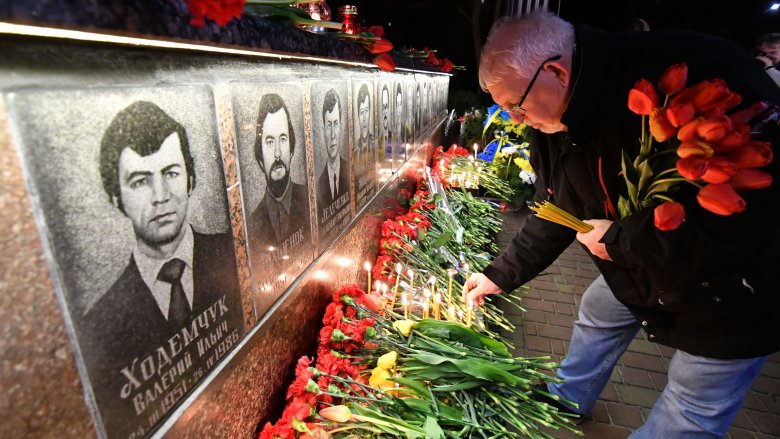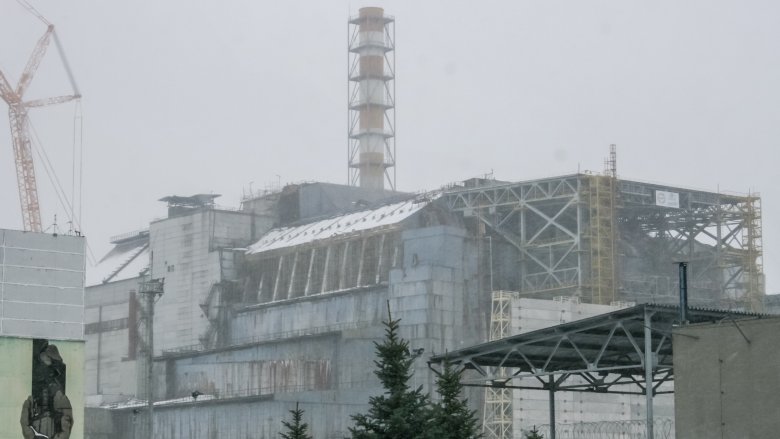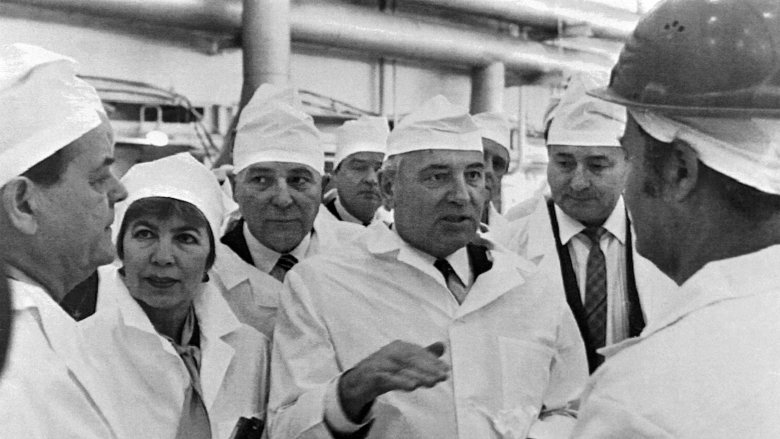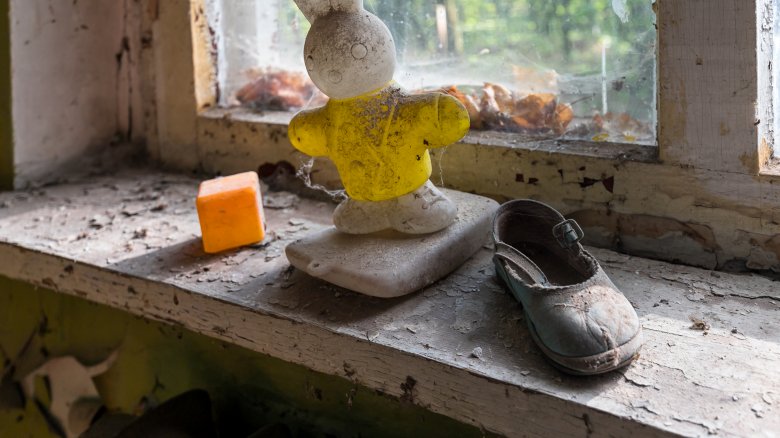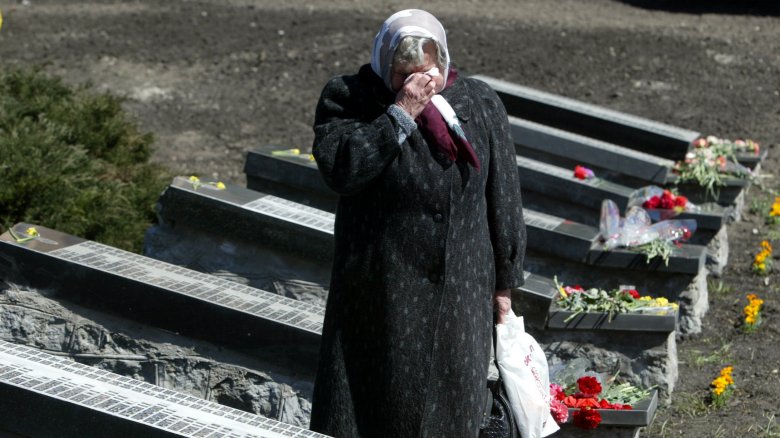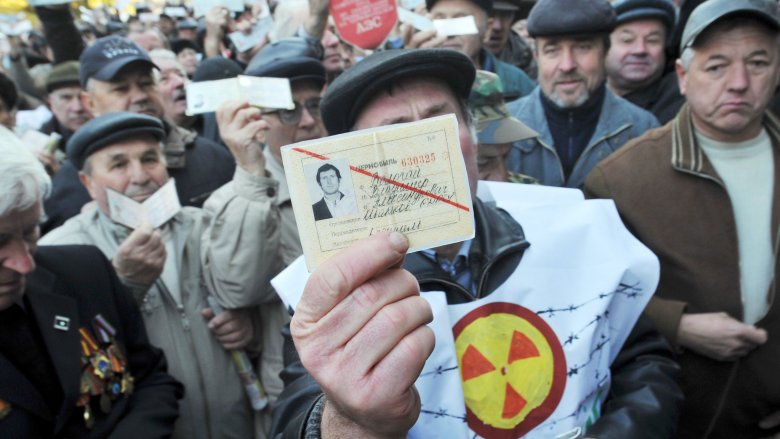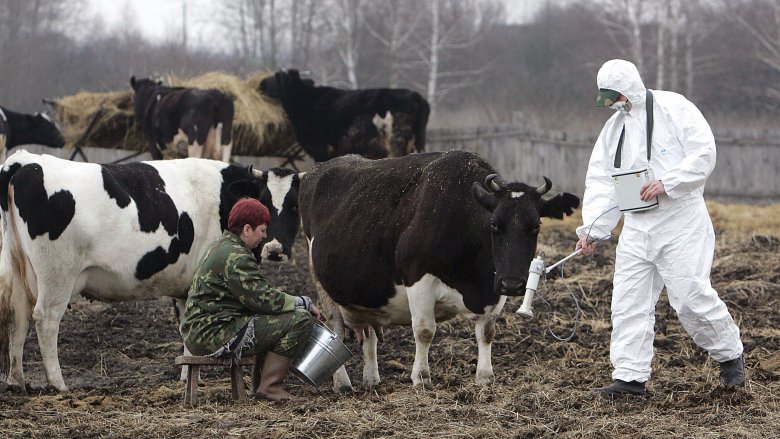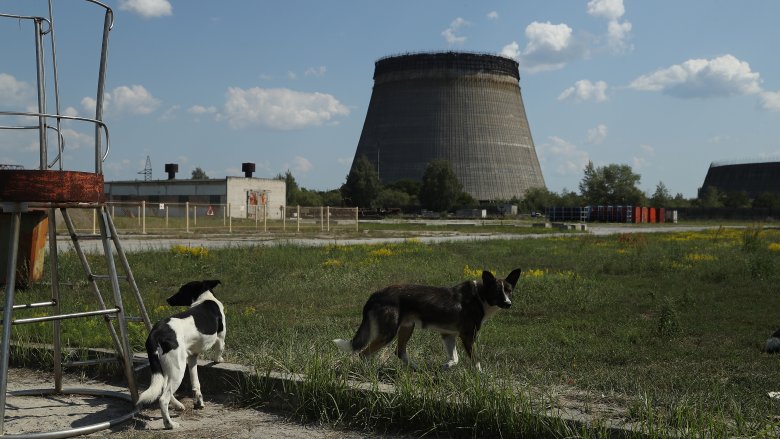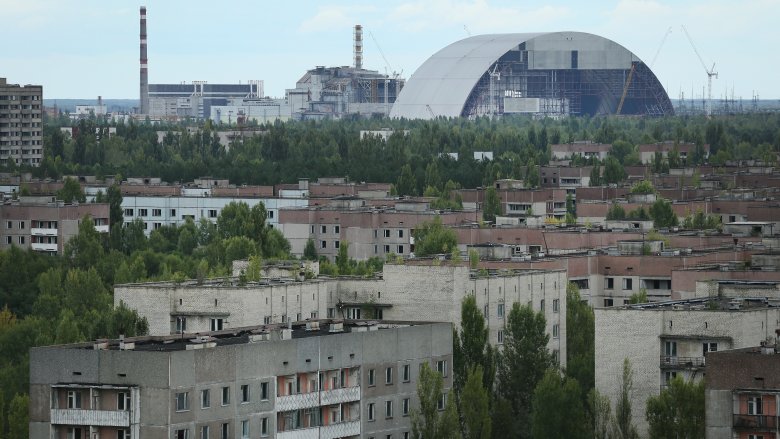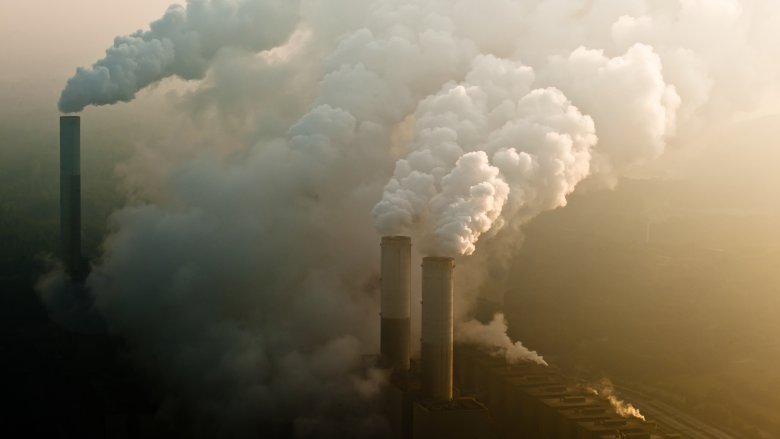The Most Disturbing Part Of The Chernobyl Disaster Isn't What You Think
On April 26, 1986, there was a catastrophic accident at the V. I. Lenin Nuclear Power Plant in the USSR. Colloquially known as Chernobyl for a nearby town, the meltdown was, and still is, the biggest nuclear disaster of all time.
You might think the worst thing about the accident was how many people it killed, but amazingly, no one knows just how many that was. According to New Scientist, two people died immediately from the explosion, 29 died in the hospital within a few days, and 15 people eventually died of thyroid cancer directly tied to radiation poisoning from Chernobyl. After that it's much harder to figure out. No one thinks only a couple dozen people were killed by the events at Chernobyl, but no one can agree on how bad the final number will be. Some researchers say 4,000, others 10,000, and environmental groups put the death toll "well into six figures."
While it may never be clear how many people died as a result of Chernobyl, there are plenty of terrible, arguably worse, things it caused that are more quantifiable.
It was totally avoidable
The meltdown at Chernobyl never should have happened, since there was plenty of warning something would go wrong before the reactors there had even been built. According to Midnight in Chernobyl: The Untold Story of the World's Greatest Nuclear Disaster, Chernobyl's reactors were the same kind as those at a nuclear facility in Leningrad. When those ones had powered up in 1973, at least three major problems with the Soviets' new reactor design quickly became obvious, including important differences between how the inventors predicted the design would work and how it actually did work. But no one bothered to look into those issues, which meant no one had any idea how this new type of reactor would behave in an accident.
On November 30, 1975, over a decade before the Chernobyl disaster, the Leningrad reactors suffered a partial meltdown. As the plant was brought back online after scheduled maintenance, it "began to run out of control." No one could stop the chain reaction, and radiation poured into the atmosphere.
The official line from the commission set up to discover what caused the accident was that a small manufacturing defect was to blame. What they really found were "design faults inherent in the reactor." While those findings were suppressed, the commission did make recommendations on various changes to that kind of reactor, including new safety regulations and a faster emergency protection system. They were completely ignored, and Chernobyl was built with the same fundamentally flawed reactor as Leningrad.
The coverup was completely immoral
When Chernobyl went into meltdown, from the outside, everything looked basically fine other than a relatively small fire. And the Soviet government was in no hurry to announce what happened, even to their own people. According to a New Scientist article published a year after the disaster, it was scientists in Sweden who first noticed something was up and alerted the outside world to the radioactive fallout emitting from around Kiev.
The USSR still stayed silent, even as international news covered Chernobyl as a major disaster. The Washington Post reports Moscow went so far as to officially deny anything was wrong. When their state TV finally had to admit there'd been an accident, it assured Russians the West was spreading "false propaganda," that a meltdown at Chernobyl was "virtually impossible," and that while there'd been a bit of an issue, "the trouble [had] passed." This was, of course, all complete nonsense.
Initially, though, the people living close to the biggest nuclear accident in history had no idea the danger they were facing. History says no official wanted the responsibility of ordering the reactor turned off, which led to explosions. That delay, plus a change in wind pattern, meant radiation was pouring over the nearby town of Pripyat. The government repeatedly refused to order an evacuation, and plant workers were forbidden from telling anyone about the accident. But rumors started to swirl. Finally, after two days of dithering, officials gave residents less than an hour to evacuate.
The relocated people were traumatized
Obviously, being told you have 50 minutes to pack, grab your family, leave your animals as well as larger valuables, and get out, is unbelievably stressful, no matter what the reason. And the effects were obvious on Chernobyl evacuees.
According to the World Health Organization, 116,000 people were evacuated immediately, with an additional 230,000 following over the next few years. This mass, forced relocation was "a deeply traumatic experience." The stress brought on by losing their homes and social networks is one of the often-overlooked tolls on those affected. Forced Migration Review says even as far away as Kiev, children were made to go away to summer camps (by the government, not by overly concerned parents) just in case, and pregnant women and mothers of young children were also sent away, "dividing families with little consideration for the lasting social effects."
CNN reports that while many Chernobyl evacuees suffered from anxiety and depression, it was especially hard on the old. In a culture where your connection to the land is important, one medical professional said older people who were relocated died of anguish. While it's not clear how many people died as a result of the trauma of Chernobyl, the stress from a similar meltdown at Fukushima in 2011 is estimated to have killed 1,539 people.
Perhaps the worst part was that only 25 percent of the relocations were even necessary, a paper in the Process Safety and Environmental Protection journal found, while another study said it was "groundless, both medically and socially."
The mental health toll was massive
The trauma of Chernobyl didn't end quickly. In 2013, a study at USC found millions of people were still suffering from mental problems related to the accident. Children who had been relocated were subjected to bullying in their new schools, while some adults had to deal with job loss, and there was even a resulting mistrust in doctors. Both relocated people and those who got to stay put still showed "negative psychological impact." A 2011 study found "significant neuropsychological consequences" for those affected, including diminished quality of life, depression, anxiety, and PTSD.
A 2016 article in the World Psychiatry journal noted that pregnant women, mothers, and those who cleaned up Chernobyl were in particular danger of long-term mental health issues. The cleaners, known as liquidators, had higher rates of self-harm, suicidal ideations, and common mental disorders. People in areas exposed to radiation reported poorer life satisfaction rates and socio-economic well-being than those in other places. The authors warned kids at the time might now be suffering mental issues as adults, since early childhood trauma can really mess with you.
The World Health Organization says part of the problem may have been the social stigma of being an "exposed person." The government and media also labeled those affected as "victims" rather than "survivors" of the accident, which had a negative effect on their mental state. The Lancet reported mental health issues were "the biggest public-health problem to emerge from the disaster," and they rival even the more obvious physical effects.
Pregnant women faced a horrible choice
Women have the right to terminate their pregnancies in many countries today, and this was legally the case in the USSR in 1986. However, it's important they make that decision based on accurate information, and that they certainly shouldn't be forced or tricked into ending a pregnancy they want to keep. Unfortunately, that is what happened on a massive scale after Chernobyl.
According to Vice, after the meltdown, "radiophobia" spread in society in general and among medical professionals specifically. Doctors thought the government was lying to them about how bad the contamination was, and that women who were pregnant were going to give birth to children with severe birth defects. They encouraged their patients to terminate, and 100,000 to 200,000 wanted pregnancies ended. As far away as Denmark, there was a pronounced uptick in abortions.
One nuclear engineer says it went further, telling Women's eNews that there were forced abortions, and the government secretly ordered all pregnant women within 18 miles of Chernobyl be induced early. She heavily implies if the babies were born alive, they were disposed of.
But in the end, there was no uptick in birth defects at all. In 1987, a doctor said not one child in the area was born with "any detectable abnormalities" and that they "weren't expecting any." Which does beg the question why so many women were told there would be such terrible problems. The only long-term effect on Chernobyl babies appears to be an increased rate of thyroid cancer as adults.
The people who cleaned it up were screwed over
Liquidators, the brave people who cleaned up Chernobyl for three years after the accident, were screwed over from the beginning. According to the Chernobyl Gallery, we don't know exactly how many individuals were involved, but it was hundreds of thousands. The government suppressed information on how dangerous the job was. Almost all liquidators were sent in with inadequate protection against radiation. When machines broke under the pressure, they moved the radioactive debris with their hands. One fireman said they knew it was a kamikaze mission. At least 28 died horribly within weeks, while Wired reports another 4,000 died of radiation-caused cancers down the line, and 70,000 became disabled from exposure.
You'd think the governments involved would be grateful, but the liquidators are still fighting for support today. They are much more likely to have mental health problems, as well as physical problems, so life is difficult for a lot of them and they depend on the state for help. In 2006, Russian media reported a group of liquidators took the government to court demanding monetary compensation for the damage to their health. That same year, liquidators protested in Kiev, saying Ukraine was quickly forgetting about them and cutting their benefits. 2011 saw thousands of Estonian Chernobyl veterans rally in support of the 1,300 who get no financial support from the state at all. And Ukraine hadn't made any positive strides in five years, because in 2011, 40 liquidators there went on hunger strike to protest further benefit cuts.
Children probably got cancer from drinking milk
The most pronounced long-term physical health effect among survivors of Chernobyl is thyroid cancer. Kids especially appear to have gotten cancer from drinking radioactive milk, per the United Nations. Since children drink a lot of milk and have different metabolisms and smaller thyroids than adults, they were more susceptible to developing cancer there. By 2005, 6,000 people who were children and adolescents at the time of the disaster developed thyroid cancer. According to an article in the Belgian Journal of Geology, removal of the thyroid resulted in a distinct neck scar that became known as the "Chernobyl necklace" and carried a stigma with it. The good news is, virtually all the individuals who got thyroid cancer survived.
Amazingly, the issue isn't over. The Independent reports that in 2016, a journalist in what is now Belarus saw cows grazing near signs warning radiation was higher than normal. When offered a glass of milk, he sent a sample to a lab to see if it was still dangerous all these years on, and it was. When he wrote an article telling the public the milk's radioactive isotope level was 10 times higher than the safe level, the dairy company involved sued him. The government also wanted to suppress the findings, since milk is a huge export for the country and pointing out it's still affected by Chernobyl wouldn't be good for the economy. The company won the suit, so plenty of people in the area are still drinking contaminated, potentially cancer-causing milk.
Animals had it rough
The animals around Chernobyl didn't get a warning there was radiation everywhere, and if they had they probably would have kept mating anyway, since, you know, they're animals. But Chernobyl affected them badly. According to ThoughtCo, ranchers noticed a dramatic increase of genetic abnormalities in farm animals born after the accident. The pictures are horrible, like those of an eight-legged foal and a cow with its mouth and nose the wrong way around. The birth defects continued showing up for years. They were so severe the animals usually only lived a few hours, so at least they didn't grow up and breed, passing on their issues.
National Geographic says the debate over how animals living near Chernobyl are doing now is the "scientific equivalent of a boxing match." While there are signs wild animals are thriving, some studies say not so much. Reuters reported in 2009 there was still a "high incidence of deformed animals" living near Chernobyl. Barn swallows appear to be badly affected, and grazing animals like elk may look fine, but they have high rates of radiation in their bodies. Aquatic organisms face "ongoing genetic instability" and invertebrates (basically all insects and spiders) have a very hard time of it.
There's also the Chernobyl dog population. While the pets left behind bred successfully and seem to be thriving, since dogs get into everything and they may have high levels of radiation, visitors are told not to pet them, meaning all the good boys and girls must go without belly rubs.
The area might not be safe for thousands of years
You'd think with how advanced technology is, with the Soviet Union collapsing shortly after Chernobyl, and with the disaster over 30 years ago, the area would be cleaned up by now. Not even close. According to McClatchy, by some estimates, much of the area won't be safe for human habitation for 3,000 years. One geologist thinks it's more like a million.
When the reactor blew, it only lost 5 percent of its enriched uranium. That means 190 tons are still in Chernobyl's shell. It's now part of a "radioactive blob of uranium, concrete, steel and assorted junk weighing about 2,000 tons." Unfortunately, the technology to safely take that blob apart and dispose of it doesn't exist yet, and won't for a few decades in even the best-case scenarios. The only option currently available is containing the site underneath a new "sarcophagus," built in 2017, but even that will only last 100 years. One Ukrainian energy policy expert's actual solution is, "We will have smart children and smart grandchildren who in 100 years or so will figure out what to do."
The logistics of containing what is effectively an unplanned nuclear waste dump until the year 4986, assuming humans are still around, are almost beyond comprehension. Still, some people aren't willing to wait and have moved back to just outside, or occasionally in, the exclusion zone. But even the "good" area is still radioactive, and some residents go about their daily lives with Geiger counters around their necks.
It indirectly hurt the environment
By the time of the Chernobyl disaster, people knew fossil fuels were terrible for the environment. But nuclear meltdowns are also bad, and having the planet die slowly is a lot less scary than a nuclear plant that could kill you tomorrow.
According to the International Panel on Fissile Materials' 2010 report "The Uncertain Future of Nuclear Energy," nuclear power was thought to be the next big thing in the 1970s. Compared to coal it was cheap and much better for the planet. But then Three Mile Island and Chernobyl happened within seven years, and effectively "ended the rapid growth of global nuclear-power capacity." After the second accident, almost everyone accepted fossil fuels as the better route. The U.S. didn't open a single nuclear power plant between 1996 and 2016. Meanwhile, it, and almost all other countries, have been burning fossil fuel like there's no tomorrow. Now people are finally starting to realize if countries keep doing that there may not be a tomorrow, and the opinion of nuclear energy, the greenest energy available on a large-scale, has become "more favorable."
Nuclear was probably the better choice from the beginning, in terms of body count. Deadly meltdowns are vanishingly rare, and Chernobyl could kill an estimated 4,000 people. But Wired reports that every single year in the U.S., "particulate matter from coal power plants" kills about 7,500 people. So a switch to nuclear, which Chernobyl helped delay, could have saved some of those lives, plus slowed down the destruction of the environment.
Global warming is going to give the radiation back a second time
Chernobyl gave Earth a major dose of radiation in 1986, and global warming (which Chernobyl helped speed up) is going to make sure it's a gift that keeps on giving. According to Phys.org, in 2019, scientists studied glaciers in 17 sites across the world, from the Arctic to the Alps to the Antarctic. They found the levels of radioactive material were "some of the highest levels you see in the environment outside nuclear exclusion zones" — in some cases, 10 times higher. Every single site had nuclear fallout present, and not deep down, but on the rapidly melting surface ice.
To be fair, it's not all Chernobyl's fault. Any time radioactive material is released into the atmosphere, whether from nuclear tests or the bombings of Japan or other meltdowns, it ends up mixing with clouds. If it falls as snow onto the ice, the heavy sediment results in concentrated levels of nuclear residue. To be less fair to Chernobyl, it released so much radioactive stuff into the atmosphere that when researchers took core samples of the glaciers, they could see a "clear spike" in nuclear sediment from it.
The main concern is americium, which is produced when plutonium decays and has a half-life of 400 years. It's soluble, which means it will probably end up in the food chain as global warming melts the glaciers, although worryingly there isn't enough data to know how much of the "particularly dangerous" element could make it back to humans.
